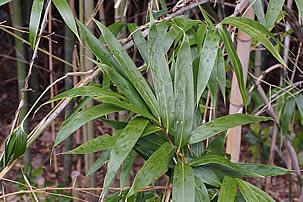The Arrow Bamboo (Pseudosasa japonica), also known as metake, is an ornamental species with a semi-woody texture and a shrubby appearance, native to Japan and Korea. It is a clump-forming bamboo that creates dense clumps over a strong rhizome. It features erect to slightly recurved, slender, cylindrical culms with persistent sheaths, all in a green color.
The stems reach a height of 6.5 to 13 feet (2 to 4 meters). Its leaves are lanceolate to linear, pointed, shiny, dark green on the upper surface, and glaucous on the lower surface. The leaves of arrow bamboo are relatively large compared to other ornamental bamboo species. It rarely flowers, but when it does, it can happen at any time of the year, producing panicle-type inflorescences composed of pseudospikelets, with hermaphroditic flowers pollinated by the wind.

In landscaping, arrow bamboo demonstrates great versatility and invariably creates a zen and tropical atmosphere. It can be used individually as a focal point or in groups, serving as a backdrop for other species. Its use in rows, as both informal and formal hedges through shaping pruning, is also quite interesting.
Densely packed arrow bamboo hedges are excellent for noise and dust control, as well as forming a perfect visual barrier, providing privacy to spaces. It thrives in containers, enhancing both outdoor and well-lit indoor areas. It is one of the most resistant bamboos to the salinity of maritime winds, making it ideal for coastal areas. However, care must be taken to contain the plant within beds, using underground barriers, as it can become invasive in certain situations.
It should be cultivated in full sun or partial shade, in any type of soil, preferably fertile, well-draining, enriched with organic matter, and regularly irrigated. Originating from a temperate climate, arrow bamboo is ideal for mountainous areas where other more tropical bamboo species may not thrive. Over time, some culms may become old and dry, giving a somewhat neglected appearance to the clump. In this case, removing these stems restores a vigorous look to the plant. It can be propagated through rhizome division and clump division.

